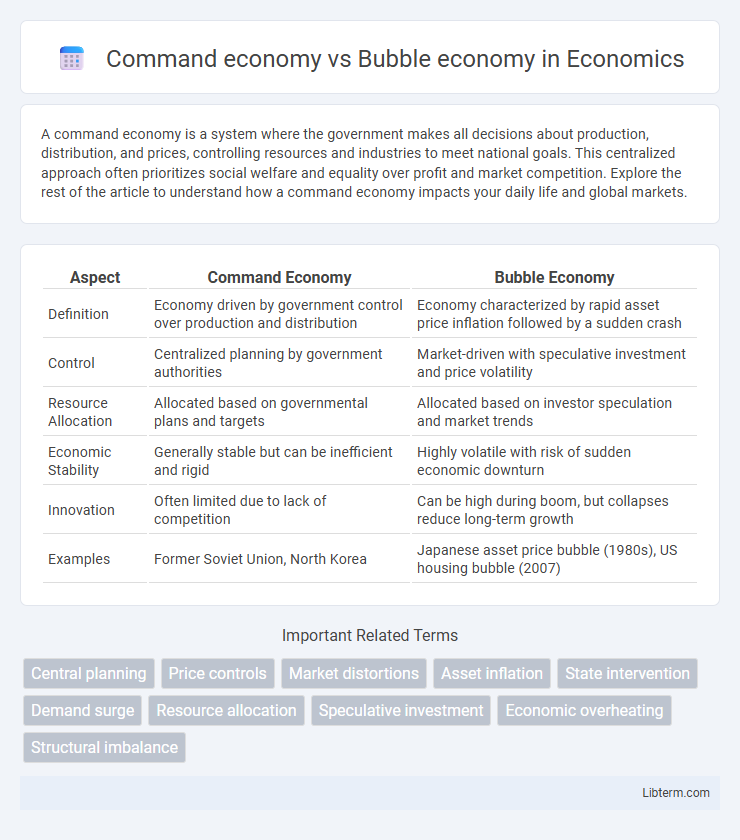A command economy is a system where the government makes all decisions about production, distribution, and prices, controlling resources and industries to meet national goals. This centralized approach often prioritizes social welfare and equality over profit and market competition. Explore the rest of the article to understand how a command economy impacts your daily life and global markets.
Table of Comparison
| Aspect | Command Economy | Bubble Economy |
|---|---|---|
| Definition | Economy driven by government control over production and distribution | Economy characterized by rapid asset price inflation followed by a sudden crash |
| Control | Centralized planning by government authorities | Market-driven with speculative investment and price volatility |
| Resource Allocation | Allocated based on governmental plans and targets | Allocated based on investor speculation and market trends |
| Economic Stability | Generally stable but can be inefficient and rigid | Highly volatile with risk of sudden economic downturn |
| Innovation | Often limited due to lack of competition | Can be high during boom, but collapses reduce long-term growth |
| Examples | Former Soviet Union, North Korea | Japanese asset price bubble (1980s), US housing bubble (2007) |
Introduction to Command and Bubble Economies
Command economies are characterized by centralized government control over production, distribution, and pricing, aiming to allocate resources based on planned objectives rather than market forces. Bubble economies, on the other hand, emerge from speculative investment and inflated asset prices that deviate from intrinsic values, often leading to economic instability when the bubble bursts. Understanding the fundamental differences between these economic systems highlights how control mechanisms and market behaviors influence overall economic performance and risk exposure.
Defining Command Economy: Structure and Features
A command economy is an economic system characterized by centralized government control over production, resource allocation, and pricing, where the state directs economic activity to achieve specific objectives. Key features include public ownership of resources, planned output targets, and the absence of market-driven supply and demand mechanisms. This structure aims to eliminate market inefficiencies and promote equitable distribution, contrasting sharply with market economies prone to speculative bubbles.
Bubble Economy Explained: Causes and Characteristics
A bubble economy occurs when asset prices inflate rapidly due to speculative demand, diverging significantly from their intrinsic values. Key causes include excessive credit expansion, investor overconfidence, and herd behavior, which lead to unsustainable price increases. Characteristics of a bubble economy involve high market volatility, rampant speculation, and an eventual sharp correction or crash that can trigger severe economic disruptions.
Historical Examples of Command Economies
The Soviet Union exemplifies a command economy where the government controlled production, distribution, and pricing, resulting in rapid industrialization but inefficiencies and shortages. China's transition from a strict command economy under Mao Zedong to a more market-oriented system after 1978 highlights the challenges of rigid economic planning. North Korea remains a contemporary example of a command economy, maintaining state control over resources but facing chronic economic stagnation and isolation.
Notable Instances of Bubble Economies
The South Sea Bubble of 1720 is a classic example of a bubble economy where speculative investments led to a catastrophic market crash. Japan's asset price bubble during the late 1980s witnessed inflated real estate and stock prices that collapsed in the early 1990s, triggering a prolonged economic stagnation known as the "Lost Decade." The United States experienced the dot-com bubble from 1995 to 2000, characterized by excessive speculation in internet-based companies, culminating in a steep market decline after 2000.
Key Differences Between Command and Bubble Economies
Command economies are characterized by centralized government control over production, resource allocation, and pricing, emphasizing planned economic activity to achieve societal goals. Bubble economies, on the other hand, are driven by speculative asset price increases, often fueled by excessive market optimism and credit expansion, leading to unsustainable economic growth followed by sharp corrections. The key differences lie in the control mechanisms--government planning versus market speculation--and the stability outcomes, with command economies aiming for stability through regulation, while bubble economies experience volatility due to speculative bubbles.
Economic Outcomes: Stability vs Volatility
Command economies often yield economic stability due to centralized control over production and pricing, which reduces market fluctuations and allows for predictable resource allocation. In contrast, bubble economies experience significant volatility driven by speculative asset price inflation and market hype, creating cycles of rapid growth followed by sharp contractions. The stability in command economies may suppress innovation and efficiency, while bubble economies risk financial crises and severe economic downturns due to their inherent unpredictability.
Government Intervention: Control vs Speculation
In a command economy, government intervention is characterized by direct control over production, pricing, and resource allocation to achieve planned economic goals. Contrastingly, a bubble economy thrives on speculative investment, where limited government oversight allows market prices to inflate rapidly beyond intrinsic values. The tension between centralized regulation and market-driven speculation significantly influences economic stability and growth prospects.
Social and Political Impacts of Each Model
A command economy often results in limited individual freedoms and centralized political control, leading to reduced innovation and potential social discontent due to state-imposed resource allocation. In contrast, a bubble economy can create short-term wealth and social mobility but tends to cause economic instability, increasing inequality and political pressure when market crashes occur. Both models significantly influence social structures and political power dynamics through their distinct economic mechanisms.
Lessons Learned: Future Implications for Global Economies
Command economies highlight the risks of centralized control leading to inefficiencies and stifled innovation, while bubble economies reveal the dangers of speculative asset inflation causing market volatility and crashes. Lessons learned emphasize the need for balanced regulation that fosters sustainable growth without excessive intervention or laissez-faire extremes. Future global economies should integrate transparent governance, diversified investment strategies, and adaptive policies to mitigate systemic risks and promote long-term stability.
Command economy Infographic

 libterm.com
libterm.com